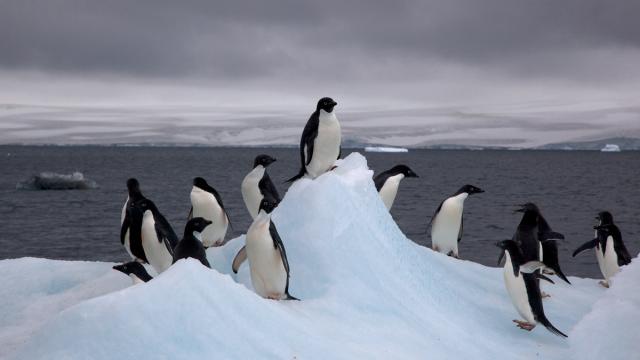It’s an observation repeated loud and often by climate deniers: while Greenland melts like a popsicle in the summer sun, Antarctica is staying chill. Parts of the coastline are actually gaining sea ice. According to a new scientific paper, there’s no conspiracy to be found here, but rather, a manifestation of global ocean currents. In fact, the waters surrounding Antarctica could be the last place on Earth to feel the burn of global warming.
Adélie penguins on an iceberg in Antarctica. Image: Wikimedia
Like a vast conveyor belt, the ocean transports energy in the form of heat across our planet. In places like northwest Europe, currents acts as a radiator, delivering heat from elsewhere. In other parts of the world, the ocean behaves more like an AC unit, siphoning extra heat away.
In stable periods, ocean currents help regulate our planet’s climate, but when the climate is changing, this same conveyor belt can amplify differences. Case in point: the north and south poles. Nowhere is the impact of global warming more visible than the the Arctic, where ice is retreating further and further each summer. Meanwhile at the other end of the world, the vast Southern Ocean encircling Antarctica has barely warmed up at all. Even as scientists warn of the dire consequences of West Antarctic ice sheet collapse, sea ice has been growing along parts of the Antarctic coastline.
A study appearing in this week’s Nature Geoscience may offer an explanation. Combining observational data from Argo floats and satellites with global circulation models, a team led by the University of Washington and MIT showed that as the surface of the Southern Ocean heats up, warm water is blown northward by currents. It will eventually end up around the north pole.
At the same time, new water is entering the Southern Ocean from the coldest and deepest basins on Earth. This deep water represents the tail-end of an incredibly slow-moving oceanic conveyor belt that begins centuries earlier in the North Atlantic. In other words, the sea water encircling Antarctica hails from a time before the industrial revolution or human-caused climate change were even a thing.
“The Southern Ocean is unique because it’s bringing water up from several thousand meters [as much as 3km],” lead study author Kyle Armour said in a statement. “You have a lot of water coming to the surface, and that water hasn’t seen the atmosphere for hundreds of years.”
Armour stressed that his study did not directly address warming on the Antarctic ice sheet per se, which is most affected by the coastal waters lapping up directly on the shoreline. “The mechanism we’ve identified slows the warming of the open ocean around Antarctica — but not these coastal waters directly,” he told Gizmodo in an email. Indeed, continental Antarctica and much of the coastline have been warming at a rate more comparable to the rest of the world.
The growth of sea ice surrounding Antarctica, however, may be facilitated by Armour’s mechanism of deep cold water. He’s also investigating other factors that could be contributing. “So far, we think [sea ice expansion] may be related to changes in the winds around Antarctica, which have been linked to stratospheric ozone depletion,” he said.
The study adds to a growing stack of research demonstrating the power of the oceans to shuffle the heat from human-cause climate change around, in some ways masking its impacts. But as our technology grows more sophisticated, so does our ability to shine a light in the darkest corners of our planet. As we do, it’s becoming clear that no places are going to be immune to what’s happening in the atmosphere.
